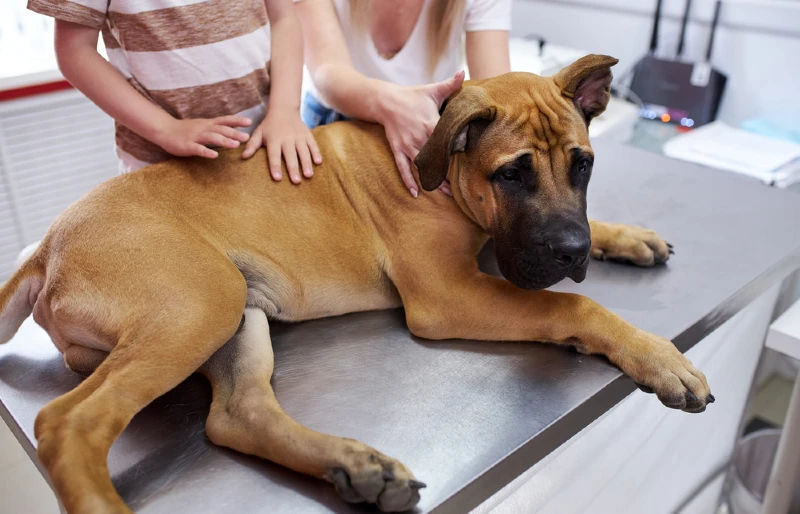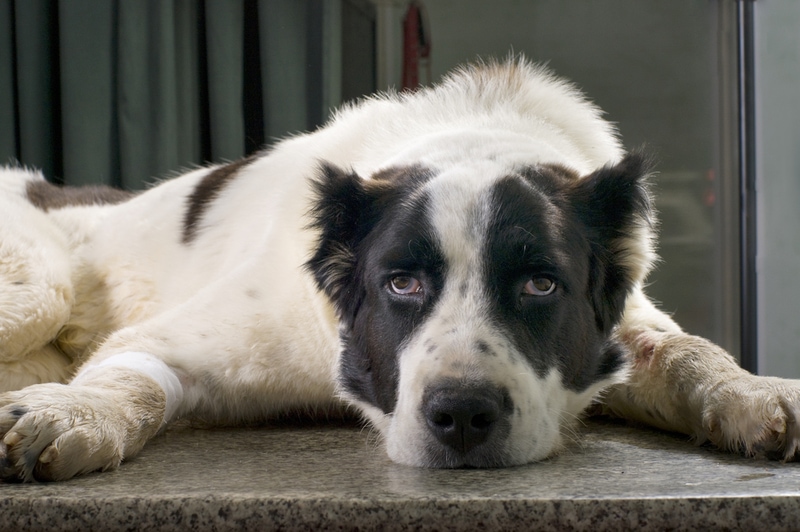Chest Bone Deformities in Dogs: Our Vet Explains the Signs, Causes & Treatment
By Dr. Leigh Wilder, DVM (Vet)
Updated on

Click to Skip Ahead
Nothing is more exciting than adding a new puppy to your family; their boundless energy, adorable antics, and sleepy cuddles are simply the best! Conversely, discovering a chest wall deformity while getting to know your new family member can feel incredibly alarming. What are you feeling, and what could it mean? How will this abnormality affect your puppy moving forward?
The following article will discuss chest bone abnormalities in dogs, including the causes, signs, and potential dangers associated with this condition. We will also review frequently asked questions about chest bone deformities, to help guide you through what this diagnosis may mean for your dog.
What Are Chest Bone Deformities?
A deformity of the anterior or front chest wall is known as a pectus anomaly. Dogs with this uncommon condition have abnormal growth of their sternum and ribs, resulting in either a convex (pectus carinatum, or PC) or concave (pectus excavatum, or PE) appearance to the front of their chest.
Both PE and PC are seen in humans, and account for 95–97% of chest wall deformities in people. While these conditions are noted to be observed commonly in children and teenagers, pectus anomaly is considered uncommon in animals.
In both dogs and humans, these conditions are known as congenital anomalies, meaning that they are present at birth; however, an acquired case of pectus excavatum has been reported in a 13-year-old Labrador Retriever.

What Are the Causes of Chest Bone Deformities?
A definitive cause of chest bone deformities in dogs is currently unknown, and the discussion of PC and PE in veterinary literature is limited. In humans, theories that have been considered as potential causes of PE include increased intrauterine pressure affecting a developing fetus, abnormality of the diaphragm, nutritional deficiency, or infectious disease. Current thoughts on the cause of this condition center on an abnormality of the sternocostal cartilage, which leads to weakness and overgrowth of affected cartilage.
In humans, a genetic predisposition for the occurrence of both PE and PC has been demonstrated. Approximately 43% of people affected by PE have a family history of the condition, and it has been shown to affect men more frequently than women. In approximately 25% of people with PC, a family history of thoracic wall deformity, thoracic vertebrae deformity, congenital heart disease, or Marfan syndrome is noted.
In dogs, a 2019 study reported a greater risk of PE in Maltese and English Bulldogs, and a greater risk of PC in pugs and French Bulldogs. Additionally, it was noted that a higher risk of PC may occur for screw-tailed brachycephalic breeds, as opposed to those with normal tails.
What Are the Signs of Chest Bone Deformities?
Thankfully, it is possible for dogs affected by chest bone deformities to remain symptom-free, or only experience minimal signs associated with pectus anomaly. In the veterinary literature, symptoms appear to be primarily reported for cases of PE as opposed to PC. When noted, these symptoms may include the following:
- Either a “pigeon chest” (PC) or “sunken chest” (PE) noted visually or felt on palpation
- Increased respiratory effort, or difficulty breathing
- Decreased appetite
- Increased respiratory noise
- Weight loss
- Coughing
- Vomiting
- Recurrent upper respiratory tract infections
- Difficulty sustaining physical activity
- Heart murmur or abnormal heart sounds
- Cyanosis (a blue or grey cast to the skin)
In addition to the above-noted signs of pectus anomaly, a condition known as swimmer syndrome may sometimes be present in puppies with PE. Puppies with this condition have their back legs, and sometimes front legs, placed in a more lateral or abducted position. They may have difficulty walking normally, and appear to make “paddling” movements with their limbs when trying to walk.

What Are the Potential Dangers of Chest Bone Deformities?
While chest bone deformities in dogs may result in either mild symptoms or a lack of symptoms altogether, it is also possible for severe cases to lead to debilitating abnormalities of the heart and lungs. In canines affected by PE, respiratory distress, or difficulty breathing is the symptom noted most frequently by owners. This may be due to the displacement of organs within the chest cavity, or impaired ventilation secondary to the inward protrusion of the chest wall.
Additionally, life-threatening compression of the heart and twisting or crimping of the blood vessels surrounding the heart may occur secondary to this deformity. The aforementioned dangers are primarily discussed in the veterinary literature as secondary to PE, as opposed to PC. However, self-limiting difficulty breathing during exercise has been documented with the latter condition.
What Are the Treatment Options for Canine Chest Bone Deformities?
Treatment may be pursued for canine chest bone deformities depending on several factors, including the severity of the abnormality, and the presence of symptoms. For dogs with mild PE, treatment may not be needed, as the condition may resolve on its own.
When treatment is indicated, the specific procedure used is often dependent on the age of the animal. Younger dogs will typically have a more flexible chest, and an external splint may be used for a period of 3–4 weeks to correct the abnormality. Older animals may require more invasive surgery, which involves the removal of part of the costal cartilage (cartilage that connects the sternum to the ribs), and placement of an internal splint along the sternum.
With regards to PC, the use of an external, compressive splint for the correction of the deformity has been documented in one canine patient; however, this resulted in cyanosis and difficulty breathing, and was promptly removed.

Frequently Asked Questions
How are chest bone deformities diagnosed in dogs?
Pectus anomaly may be diagnosed by your veterinarian during a physical exam. Chest radiographs may be recommended to better evaluate the severity of the condition, and to determine whether any other abnormalities of the heart or lungs are present. An echocardiogram, or ultrasound of the heart, can also be considered to more accurately identify any concurrent cardiac abnormalities.
What is the prognosis for chest bone deformities in dogs?
The prognosis for chest bone deformities in canines may vary depending on the severity of the abnormality. Overall, PE is considered to have a good prognosis in young animals, and even severe cases can do well with surgical correction. In humans, PC prognosis is considered to be excellent, with many affected individuals remaining asymptomatic. Similarly, symptoms in affected dogs tend to be mild, if noted at all. As such, a good prognosis is expected.
Conclusion
In summary, while uncommon in canines, chest bone deformities can occur and may be noted with higher frequency in brachycephalic dogs, such as pugs and bulldogs. If you are concerned that your dog may have a pectus anomaly, a consult with your veterinarian is recommended for further evaluation. While a diagnosis of PE or PC may be startling, as a whole, these conditions have a good long-term prognosis and most affected canines will be able to live a long, happy, and healthy life.
Featured Image Credit: didesign021, Shutterstock














